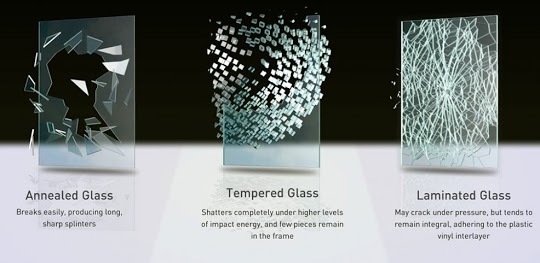
There are generally three common types of glass around your home or commercial property.
Every home is different and depending on the area and location you are wanting to install the glass determines what glass type would be best for you.
The difference in the glass is not just the thickness but also the safety aspect.
Float Glass/annealed (image on left) is the minimum standard for glass in the home. You will find it mostly in your bedroom and lounge room windows and is generally 4mm thick. When broken it can be quiet dangerous as it breaks into large sharp pieces.
Toughened Glass (Middle Image) is suited to areas of the home most prone to injury from human impact such as bathrooms, splash backs, doors and full length windows. When broken it will generally shatter into tiny little pieces which will reduce injury.
Laminated Glass (Image on right) is referred to as a Grade A Safety Glass.
It consists of two or more sheets of glass permanently bonded together with an inter layer designed to improve acoustics and/or impact resistance.
The inter layer reduces the risk of the glass breaking and forming long, dangerous shards.
To learn more the other types of glass you can have installed go to:
All glass installed in buildings shall comply with relevant Australian Standards. It is strongly recommended that builders, architects, building designers and building surveyors ensure evidence is provided. Marking of glass to ensure compliance to AS2208 is mandatory.
The use of monolithic toughened glass more than 5000mm above finished floor height may be at risk of spontaneous breakage. Toughened glass glazed monolithically should be heat soaked unless a barrier exists which will revert the fragments from falling and reduce the risk of injury.
An awning or a balcony would be considered a barrier which suits this purpose. Please refer to AS1288 for further clarification.
1. Doors
- Small panels in doors 3mm and 4mm annealed glass is permitted to a maximum of 0.1m2 and a maximum panel width of 125mm.
- Small panels in doors 5mm and 6mm annealed glass is permitted to a maximum of 0.26 m2 with a maximum panel width of 300mm
- Unframed doors other than those in bathrooms shall be glazed with toughened safety glass with a minimum of 10mm thickness.
2. Side Panels (Glass which has its vertical sight line within 300mm of door opening)
- A minumum of 5mm ordinary annealed glass may be used up to a maximum area of 0.3 m2
- For decorated glass 3mm and 4mm glass shall not exceed 0.1m2 to a maximum panel width of 125mm.
- For decorated glass 5mm and 6mm glass shall not exceed 0.26m2 to a maximum panel width of 300mm.
- Grade A Safety glass to TABLE 5.1 if the panel is within 1200mm from floor or ground level and fully framed.
3. Windows (Low Lights)
All low level glazing where the lowest sight line is less than 500mm from the ground or floor level shall be Grade A safety glass to Table 5.1 except:
in fully framed glazing ordinary annealled glass not less than 5mm is permitted to a maximum area of 1.2 m2. Larger areas of ordinary annealed glass are not permitted regardless of glass thickness.
4. Glass which could be mistaken for a doorway or opening.
Ask yourself “could anyone mistake the panel for a doorway or opening ans potentially walk into the glass”?
If yes, use Grade A safety glass
***NOTE: The panel cannot be mistaken IF:
- Opening is equal to or less than 500mm wid.
- Lowest sight line is 500mm above the floor
- The sight size height is less than 1000mm
- The glazing is opaque or patterned
- A chair rail is provided with its upper edge not less than 700mm and its top edge not more than 1000mm above the floor level.
- The panels are louvres with a blade width not greater than 230mm
- A difference in floor level of 1000mm
5. Bathrooms
All Glass in bathrooms should use Grade A or B safety glass for fully framed glazing. The only exception being a mirror, which is either fully adhered to the wall or fully protected by a vanity or bench with a minimum height of 760mm and a minimum depth of 300mm.
- Partly framed glazing shall be glazed with Grade A Safety Glass with a minimum thickness of 5mm to an area not exceeding 2.2m3
- Frameless glazing in shower screen doors and returns shall be Grade A toughened or toughened laminate with a minimum thickness of 6mm.
6. Louvre blades subject to risk of human impact
Where Grade A safety glass is required and louvres are used, those louvres shall be Grade A toughened safety glass. A nominal thickness of 5mm up to 230mm in blade width and 1000mm in blade length ie: bathrooms, side panels, aged care and schools.
7. Two Edge Unframed Glazing
Glazing with two horizontal edges unframed shall be Grade A safety glass and comply with the following.
- 5mm toughened to a maximum 1000mm span
- 6mm toughened to a maximum 1200mm span
- 6.38mm laminated to a maximum 750mm span
8. Stairway Glazing
Glazing including mirrors in stairways, shall be Grade A safety glass in the following situations:
- Within 2000mm horizontally and at right angles to the bottom riser of each stair flight.
- Withing 1000mmm and parallel to any part of the stair flight or landing.
- Safety glass is not required where the glazing is protected by a solid barrier not less than 1000mm in height.
9. Making Glass Visible
If the presence of glass is not made visible in a door, side panel or a panel capable of being mistaken for a doorway or opening and is not made apparent by other means, the glass shall be marked to make it visible.
Marking shall be in the form of an opaque band not less than 20mm in height and located so that the vertical height from the floor level is:
- Not less than 700mm from the upper edges of the band and
- Not more than 1200mm to the lower edge of the band.
Making glass visible is not a substitute for safety glazing.
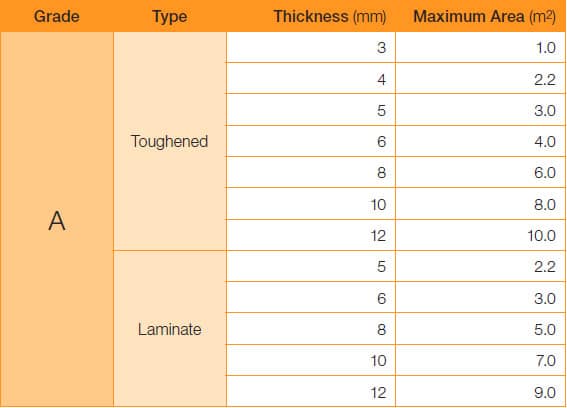
NOTE: Toughened laminate can be substituted where toughened is required.
10. Balustrades
All balustrades require an interlinking hand rail where the difference in floor level is greater than 1000mm.
Glass in balustrades which have a load supporting handrail and use glass infill panels at 1.0kPa and 0.50kN, which are framed on two opposite sides or are fully framed on all four edges, shall be a minimum of 8mm toughened to a maximum span of 1070mm between supports.
10mm toughened to a maiximum span of 1650mm supports. 12mm toughened to a maximum span of 1930mm between supports.
Span is defined as the distance between supports. For glass supported on all four edges, span is the smaller dimension.
PLEASE NOTE
- This guide applies to glass that has a maximum wind load of 1.5 ULS and .80 SLS and an aspect ratio not greater than 4.
- It only applies where panels are supported on 4 sides (except where indicated)
- This guide applies to glass that is within 2000mm of ground or floor level
Disclaimer: This post has been developed to provide general guidance, awareness and education. It should not be viewed as a definitive guide. While every effort has been made to ensure all information is accurate True Blue Glass expressly disclaims all and any liability to any person for anything done in reliance on this publication.
No responsibility is accepted by True Blue Glass for any mistakes, errors or omissions in this publication.
From Float glass to tinted glass, True Blue Glass stocks a wide range of glass types.
Every home is different and depending on the area and location you are wanting to install the glass determines what glass type would be best for you.
If you would like some advise call us to discuss what option would be best for you.
Float Glass
What is Float Glass
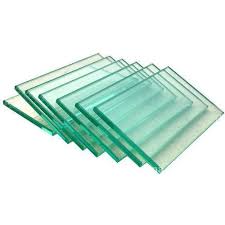
- High degree of light transmission.
- Range of colours available.
- The most common type of glass used in homes,
- Main glass type used in bedroom and lounge windows.
- Glass type used when creating laminated, toughened and coated glass.
- Variety of thicknesses and can be cut to size while onsite.
- In most cases float glass can be repaired on the first visit.
Toughened Glass
- Known as tempered glass and is created using a thermal tempering process.
- It is known for its structural durability and strength.
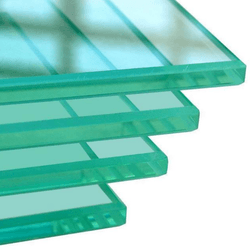
- Toughened glass is built to withstand high temperatures making it ideal for kitchen splashbacks and in bathroom areas
- The tempering process makes it highly resistant to breakages. It is good for shopfront and window displays as it helps to improve the safety and security of a property
- Toughened glass cannot be re cut after it has been toughened which means measurements have to be exact before it is ordered.
- The glass will either hold together in a million pieces or explode into safer pieces but can leave a mess.
Tinted Glass
- Color is added to the glass to create the tint look
- Density of the glass can change with the thickness of the glass
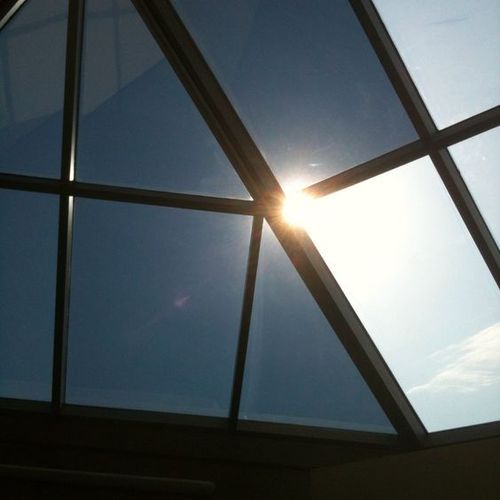
- Tinted glass is great for climate control
- UV protection – tinted glass can reduce the glare and the amount of UV rays that can come through the glass.
- Transparency is maintained from the inside but the visibility from the outside is reduced dramatically and the color of the light is changed.
- Shopping centers install these to their ceilings to still allow light to shine in but reduce the amount of heat.
- Great for homes as it can reduce your power bill and also can keep your rooms cooler throughout the summer months.
Obscure Glass
- Obscure glass is patterned or frosted to prevent the glass from being clearly seen through.
- Can be used in float, toughened or laminate glass types
- Used in domestic and commercial buildings
- There are various patterns and textures available
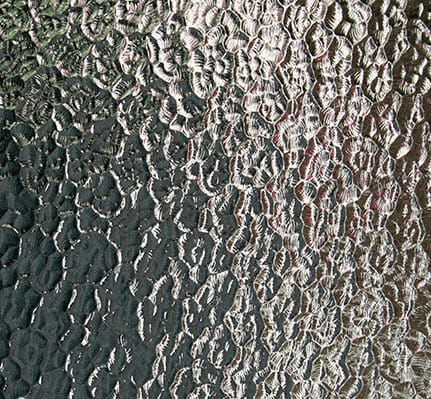
- Offers privacy but still lets light into your home
- Used as a form of decoration
- Great for bathrooms as its easily cleaned
- Used in windows and doors
Laminated safety Glass
- Laminated glass is made from two or more layers of glass separated by a bonded inter layer of plastic.
- All types of glass can be laminated
- The glass transparency is not altered.
- Considered to be a Grade A safety Glass

- Harder to break than ordinary glass.
- Sound Insulation – the extra layers can reduce traffic noises etc
- Energy efficiency
- UV reduction
- Grade A safety Glass
- Used in both doors and windows
- Will hold together when broken due to the plastic inter layer
Mirrored Glass
What is it
Metal coating is applied to one side of the glass. It is then sealed with a protective layer.
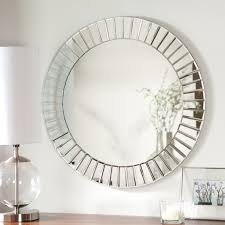
- Great for bathrooms and built in robes
- can create illusion of a larger space
- great for design and aesthetic purposes
Low E Glass
What is it?
- Developed to minimize the amount of ultraviolet and infrared light that can pass through glass without compromising the amount of visible light that is transmitted.
- Low-E glass has a microscopically thin, transparent coating
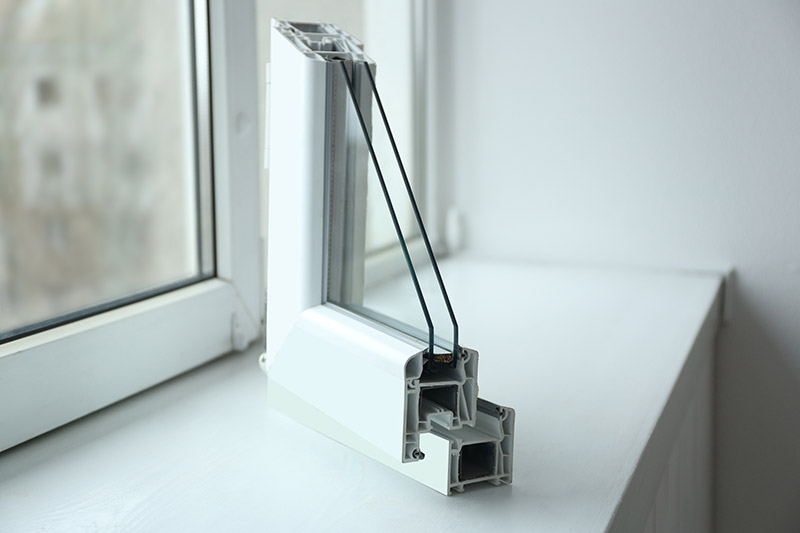
- Improves Thermal Insulation – The coatings tend to hold heat in the cod weather and reflect the heat when its warm.
- The coating is applied to the inside of the glass so it wont scratch off
- It helps protect furniture against fading
- Reduces UV lights
- It requires no special cleaning.
Coated Glass
What is it
- There are two types of coated glass, hard coat and soft coat
- Hard coat is manufactured by pouring a thin layer of metallic oxide onto a sheet of glass while the glass is still on production line.
- The metallic oxide becomes welded to the glass surface
- This process makes it very hard to scratch or remove the coating
- This sometimes creates a blueish tint to it
- Soft Coat involves the application of silver, zinc or tin to glass that has already formed and taken off the production line.
- The coating is softer.
- Soft coat is used in an insulated glass unit.
Patterned/Decorative Glass
What is it?
- Decorative design or pattern imprinted into.
- Available in toughened and laminated options safety
- Includes etched glass
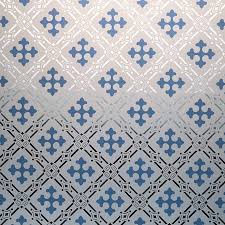
- Design and aesthetically purposes
- Privacy
- internal partitioning in patterned glass gives greater light to rooms
Wired Glass
What is it?
- Wire is inserted into the glass.
- Treated to withstand breakages
- Used in fire doors
- Considered to be a Grade B safety glass in Australia
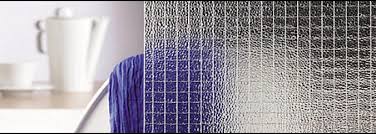
- Provides safety – it is much harder to break than standard glass
- Fire resistant
- Suitable for emergency fire doors.
Painted Glass
- Popular for splash backs
- Depending on the manufacturing process, the glass can be transferred to a large oven. This is where the paint will be “baked” onto the glass, ensuring proper adhesion.
- Some manufacturers are still able to cut, trim and polish the glass even after the painting has been completed.

Back painted glass injects style and color into any room.




